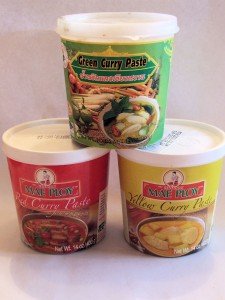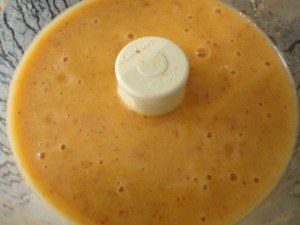As I think I’ve said before, I love hot and spicy food, which is strange because growing up in Scotland I never experienced anything hotter than black pepper until I went to university. Once you start to develop a taste for chilli heat, it becomes addictive. Sometimes all I want is the hottest thing on the menu such as a Indian Vindaloo or Phall, but I have to say that Thai curries (Thai Hot) have been some of the hottest I have ever eaten. There is nothing better than the aromatic waft of the herbs and spices, followed by the searing, endorphin racing heat, finished with some cooling steamed rice.
I love going out for Thai curries, but I sometimes crave the heat during the week and always keep pots of Thai curry paste in the fridge. These pots of curry paste allow me to throw together a delicious meal in minutes, without having to purchase the paste ingredients and make it myself. You can sometimes find these curry pastes in the ethnic isles of supermarkets or in Asian supermarkets. The types of Thai curry best known outside of Thailand is called ‘Kaeng’ and usually comes in three types, red, green and yellow.

Red Thai Curry (Kaeng phet) is usually made from garlic, shallots, galangal, red chillies, shrimp paste, salt, lemongrass, kaffir lime peel, coriander seeds, coriander root, cumin seeds and and peppercorns.
Green Thai Curry (Kaeng khiao wan) is usually made from garlic, shallots, galangal, green chillies, shrimp paste, salt, kaffir lime peel, coriander seeds, cumin seeds and white peppercorns.
Yellow Thai Curry (Kaeng kari) is usually made from garlic, salt, turmeric, fenugreek, cinnamon, ginger, cayenne pepper, mace, cumin, coriander, bay leaf and lemongrass.
Once you have these pots of curry paste, and a tin of coconut milk you can throw together a meal quickly with whatever is lying around in the fridge. Usually I use mountains of vegetables and a little meat, which is usually frozen prawns, squid or leftover meat from another meal.
Ingredients (serves 2)
- 1 tbls Thai Curry Paste – Red, Green or Yellow
- 1 cup (240ml) of coconut milk
- 0.5lbs (250g) of meat, chopped into small strips – Prawns, Squid, Chicken, Beef, Pork, etc
- 0.25lbs (125g) of vegetables, chopped into small pieces – Carrots, peppers, bok choy, green beans, broccoli, green onions, etc

Method
In a wok or large frying pan, stir fry the curry paste in oil. Add the coconut milk and stir until the curry paste has dissolved. Add the meat and cook for a couple of minutes (less if it is already cooked). Add the vegetables and cook until they just soften. Serve by itself or with rice.


















